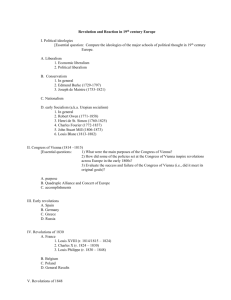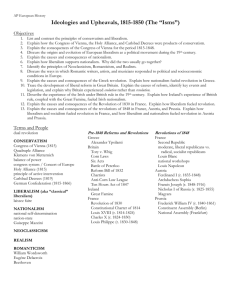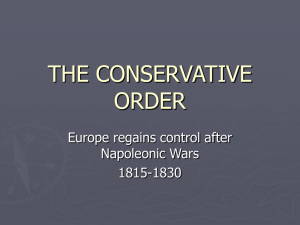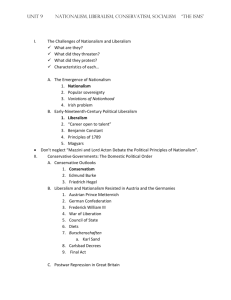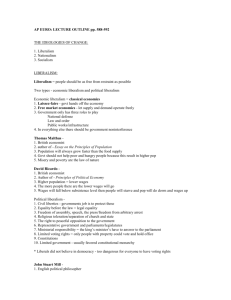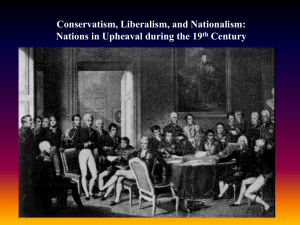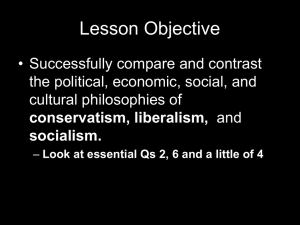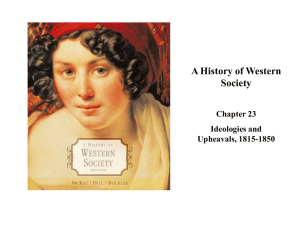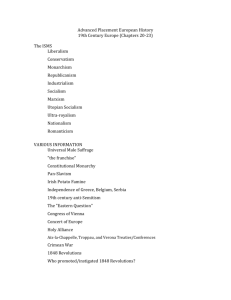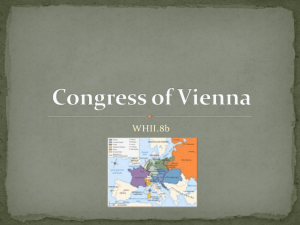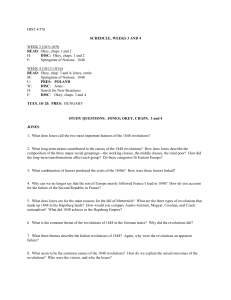Chapter 21 Focus Questions What were the goals of the Congress of
advertisement
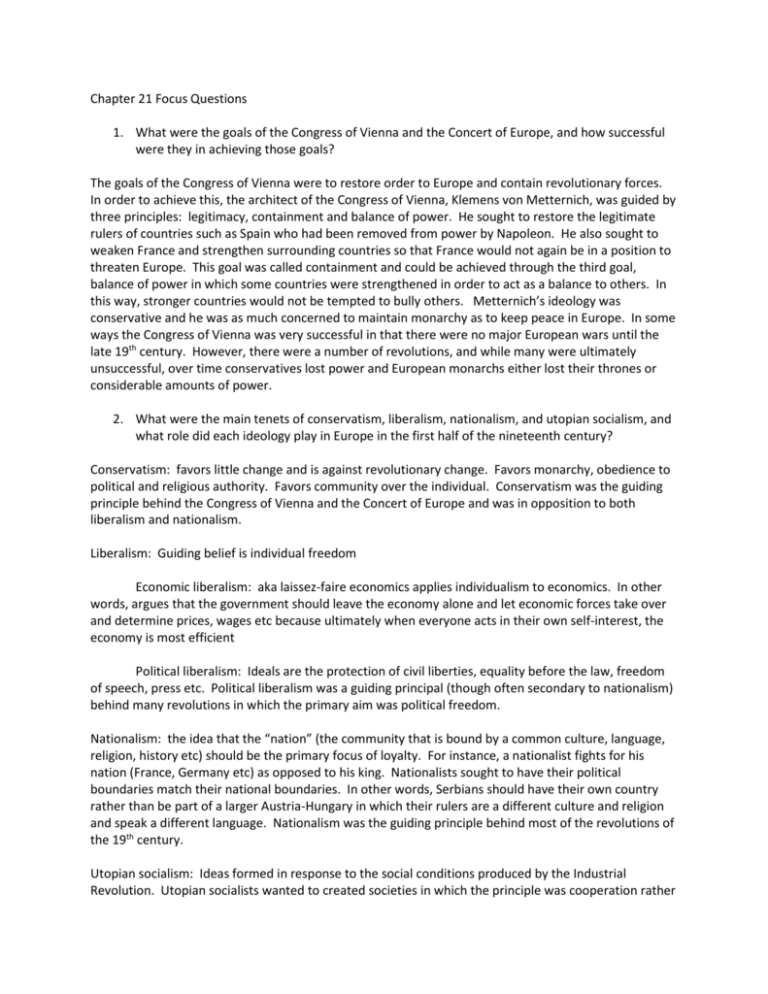
Chapter 21 Focus Questions 1. What were the goals of the Congress of Vienna and the Concert of Europe, and how successful were they in achieving those goals? The goals of the Congress of Vienna were to restore order to Europe and contain revolutionary forces. In order to achieve this, the architect of the Congress of Vienna, Klemens von Metternich, was guided by three principles: legitimacy, containment and balance of power. He sought to restore the legitimate rulers of countries such as Spain who had been removed from power by Napoleon. He also sought to weaken France and strengthen surrounding countries so that France would not again be in a position to threaten Europe. This goal was called containment and could be achieved through the third goal, balance of power in which some countries were strengthened in order to act as a balance to others. In this way, stronger countries would not be tempted to bully others. Metternich’s ideology was conservative and he was as much concerned to maintain monarchy as to keep peace in Europe. In some ways the Congress of Vienna was very successful in that there were no major European wars until the late 19th century. However, there were a number of revolutions, and while many were ultimately unsuccessful, over time conservatives lost power and European monarchs either lost their thrones or considerable amounts of power. 2. What were the main tenets of conservatism, liberalism, nationalism, and utopian socialism, and what role did each ideology play in Europe in the first half of the nineteenth century? Conservatism: favors little change and is against revolutionary change. Favors monarchy, obedience to political and religious authority. Favors community over the individual. Conservatism was the guiding principle behind the Congress of Vienna and the Concert of Europe and was in opposition to both liberalism and nationalism. Liberalism: Guiding belief is individual freedom Economic liberalism: aka laissez-faire economics applies individualism to economics. In other words, argues that the government should leave the economy alone and let economic forces take over and determine prices, wages etc because ultimately when everyone acts in their own self-interest, the economy is most efficient Political liberalism: Ideals are the protection of civil liberties, equality before the law, freedom of speech, press etc. Political liberalism was a guiding principal (though often secondary to nationalism) behind many revolutions in which the primary aim was political freedom. Nationalism: the idea that the “nation” (the community that is bound by a common culture, language, religion, history etc) should be the primary focus of loyalty. For instance, a nationalist fights for his nation (France, Germany etc) as opposed to his king. Nationalists sought to have their political boundaries match their national boundaries. In other words, Serbians should have their own country rather than be part of a larger Austria-Hungary in which their rulers are a different culture and religion and speak a different language. Nationalism was the guiding principle behind most of the revolutions of the 19th century. Utopian socialism: Ideas formed in response to the social conditions produced by the Industrial Revolution. Utopian socialists wanted to created societies in which the principle was cooperation rather than competition. While there were a number of attempts to put these ideas into practice, none were enduring. 3. What forces for change were present in France and Great Britain between 1830 and 1848, and how did each nation respond? What were the causes of the revolutions of 1848, and why did the revolutions fail? In France the struggle between the liberals and the conservatives led to upheaval. King Charles X issued the July Ordinances imposing censorship and dissolving the legislature. In response, the French people rebelled and put a liberal constitutional monarchy in place with Louis-Philippe as king (Charles X fled). Louis-Philippe favored the upper-middle class liberals and made liberal changes as lowering financial qualifications for voting (in other words, still excluding the lower classes). These changes didn’t satisfy the lower-middle and working classes who were still excluded from voting and were frustrating with conditions brought about by the Industrial Revolution. In Britain, they witnessed the upheaval in France and decided that making concessions to the lower and lower-middle classes was preferable to revolution. The Reform Act of 1832 gave the new industrial cities more power in government, the property qualification for voting was lowered (though still excluding most people). This primarily benefitted the upper-middle class. The Poor Law of 1834 created workhouses in which the unemployed were forced to live and work in horrible conditions. The belief was that this would encourage people to be industrious whereas relief for the poor encouraged laziness. In addition, repeal of the Corn Laws lowered bread prices. These moderate liberal changes prevented there from being a revolution in 1848. Causes of the revolutions of 1848 included liberalism, nationalism. There was a depression in France which led to high levels of unemployment and food shortages. The Revolutions of 1848 failed for two primary reasons. First of all, once the revolutions occurred, class divisions led to problems. The liberal middle class did not want to give the vote to the working classes. As the lower classes pushed for universal male suffrage, liberals aligned themselves with the upper class for fear of radical revolution taking away their property and position. 4. How did Europe respond to the need for order in society in the first half of the nineteenth century? Revolution and increases in crime associated with urbanization led many of the upper and middleclasses to look for ways to increase safety and order. One way they sought to do this was by creating formal police forces. Another way was by creating poor laws in which unemployed people were forced into crowded, unpleasant workhouses to encourage them to find work on their own. Others believed that if crime was associated with poverty, the answer was training which would lead to technical skills and therefore higher wages. Prison reformers sought ways to not only incarcerate and isolate criminals, but to reform them as well. 5. What were the characteristics of Romanticism, and how were they reflected in literature, art and music? The characteristics of Romantic literature included an emphasis on emotion, sentiment and inner feelings; individualism; heroism. Ex: Goethe’s Sorrows of the Young Werther and the fairy tales of Hans Christian Anderson, Mary Shelley’s Frankenstein Romantic poetry also included an emphasis on love of nature, in some cases embracing pantheism and tending to be critical of science. Ex: Percy Bysshe Shelley Prometheus Unbound and Lord Byron’s Childe Harold’s Pilgrimage Romantic artists deliberately rejected classicism’s order and restraint in favor of an emphasis on the artists inner feelings. Ex: Caspar David Friedrich, Joseph M. W. Turner, Eugene Delacroix Be sure to also be familiar with characteristics of realism and neoclassicism as well as the works we looked at in class.
